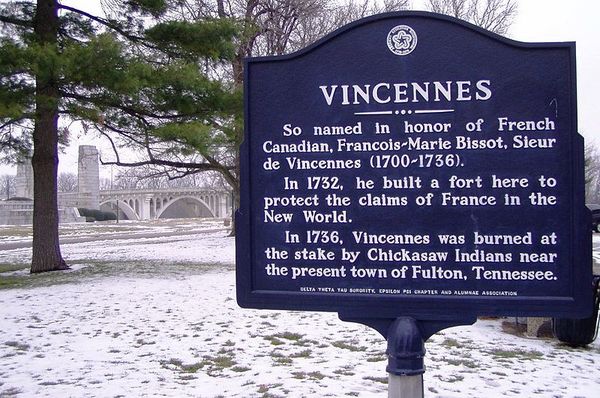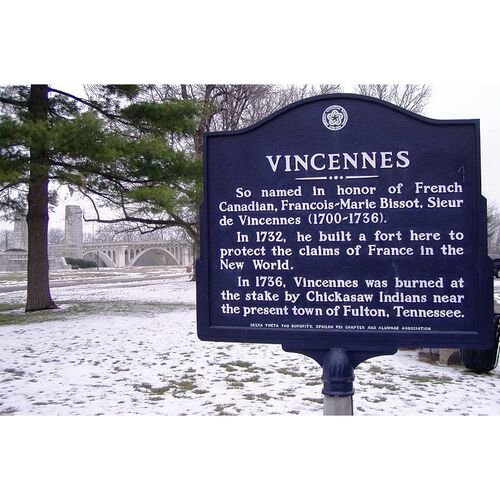
Source: Courtesy of Wikimedia Commons
BISSOT DE VINSENNE (Vincennes), FRANÇOIS-MARIE, second ensign in the regular troops of Canada and half-pay lieutenant in those of Louisiana, commandant of the posts of the Ouyatanon (Wea), near what became Lafayette, Indiana, and of the Peanguichia (Piankeshaw), subsequently called Vincennes, on the Ouabache (Wabash) River; b. 17 June 1700 in Montreal; eldest son of Jean-Baptiste Bissot de Vinsenne and of Marguerite Forestier; m. presumably Marie Longpré in Kaskaskia in 1733; d. 25 March 1736, killed by the Chickasaw near what became Fulton, Mississippi.
Vinsenne spent almost his entire life among the Miami people. A letter he wrote in 1733 shows that he was only 13 years old when he first accompanied his father on a trip to visit them. In 1718 he was posted among the Ouyatanon Miami, who lived on the upper Ouabache, and within the next four years he was appointed commandant of the Ouyatanon post. Although still only a cadet in the colonial regular troops, this young officer was already noted for his skill in dealing with Indigenous people.
In the mid 1720s the area in which Vinsenne was posted was assuming great strategic importance. By using the river system of the Ouabache and the Belle Rivière (Ohio) the British, who had been intensifying their pressure on the west since the treaty of Utrecht, would be able to enter the Mississippi valley and disrupt communications between Canada and Louisiana. The Compagnie des Indes, to which the ownership of the southern colony had been granted in 1717, feared that this incursion would entail the loss of the Illinois territory and might eventually cause the ruin of the French North American empire. To cope with the British threat, it revived the plans which had first been formulated in 1713 to build a post in the region where the Ouabache, the Rivière des Cheraquis (Tennessee), and the Cumberland River joined the Belle Rivière. The commanding officer who would be posted at this crucial point would be expected to cooperate with Vinsenne in blocking English penetration of the west and protecting communications between the two French colonies.
Unable or unwilling to make the expenditures necessary to build this post and to stock it with goods for trade, the company did not carry out its plan. To maintain control of the region it relied on Vinsenne, whose influence over the Miami gave him considerable power. Thus, while he was still under Canadian jurisdiction, this officer gradually became an agent of Louisiana. He held the rank of half-pay lieutenant in the southern colony’s regular troops and also received an annual subsidy from its government consisting of a gratuity of 300 livres, which was added to his regular salary, and a sum of 800 livres to purchase gifts for Indigenous people.
In 1730 Vinsenne severed his connections with Canada by moving down the Ouabache with a contingent of Miami. On 1 July of the following year the Compagnie des Indes ceded Louisiana to the crown and immediately afterwards steps were taken to have a post erected near the junction of the Ouabache and the Belle Rivière. Vinsenne appears to have begun the construction of this establishment late in 1731 and to have completed it early the following year. In 1733 he described it in one of his dispatches to Jean-Baptiste Le Moyne* de Bienville, the governor of Louisiana. It was located some 80 miles up the Ouabache, near what became Vincennes, Indiana, and consisted of two buildings surrounded by a palisade. Five Indigenous groups that could field between 600 and 700 warriors lived nearby in four villages. The commandant complained that a lack of troops and trade goods was making it difficult for him to control them. On occasion, to present them with gifts, he had to borrow from travellers or draw upon his personal belongings. The situation was further complicated in 1735 when the British appeared on the Belle Rivière and made efforts to win them over.
Early in 1736, Vinsenne and several Miami warriors set off for Fort de Chartres in Illinois territory to join forces with Pierre d’Artaguiette, who was preparing an expedition against the Chickasaw. Inhabiting an area made up roughly of what became the state of Tennessee and the northern parts of Mississippi and Alabama, the Chickasaw had an alliance with the British of the Carolinas; for several years they had been harassing French settlements and attacking their convoys on the Mississippi River. Finally, Bienville had decided to strike back. He drew up campaign plans that called for his force to meet that of d’Artaguiette in Chickasaw territory and march together against the enemy.
D’Artaguiette’s army, made up of approximately 140 French and 266 Indigenous fighters, was the first to arrive at the rendezvous. With supplies running low and the warriors showing signs of restlessness, the commander decided to capture three small Chickasaw villages to seize their provisions. The attack began early on the morning of 25 March. The first two villages were easily taken and the assault on the third was under way when several hundred Chickasaw warriors appeared on the scene to lend their support to their beleaguered compatriots. D’Artaguiette’s scouts had failed to notice that the three villages formed part of a much larger complex which lay half concealed in the surrounding hills. Abandoned by the Miami and the Illinois, d’Artaguiette ordered the rest of his men to retreat, but with the Chickasaw in pursuit he was obliged to stop and give battle. Despite a valiant stand by the French and their Iroquois (Haudenosaunee) and Arkansas (Quapaw) auxiliaries they were soon overwhelmed by superior numbers. The Chickasaw killed several of them during the engagement and took some 20 prisoners, including d’Artaguiette, Vinsenne, Louis d’Ailleboust de Coulonge (the younger), Saint-Ange [Pierre Groston], Louis-Marie-Charles Dutisné, and the Jesuit Antoine Sénat, who had accompanied the expedition as chaplain.
The principal sources for the events that follow are the account of an enslaved Chickasaw woman and Drouet de Richerville, who was taken prisoner but managed to escape after spending two years in captivity. The captives, except for a few who were set aside to be tortured later or to be used in prisoner exchanges, were led into the centre of one of the villages where they mounted two pyres that had been prepared by the Chickasaw women. These were then set ablaze. The victims suffered this torment without flinching. Led by Father Sénat they sang hymns and canticles in firm voices, even as the flames engulfed them.
Vinsenne was survived by his Métis wife, Marie Longpré, the daughter of a wealthy settler of Kaskaskia, whom he had most likely married in 1733, and by two daughters. His memory, like that of his father, was long honoured by the Miami.
AN, Col., B, 35, 43; C11A, 44, 52, 56, 63; C13A, 9, 11, 16, 17, 19, 20; D2C, 222; F3, 24. Découvertes et établissements des Français (Margry), VI.
Alvord, Illinois country. N. M. Belting, Kaskaskia under the French régime (University of Illinois studies in the social sciences, XXIX, no.3, Urbana, 1948), 77. J. P. Dunn, The mission to the Ouabache (Ind. Hist. Soc. pub., III, no.4, Indianapolis, 1902). Pierre Heinrich, La Louisiane sous la Compagnie des Indes, 1717–1731 (Paris, [1908 ]). Rochemonteix, Les Jésuites et la N.-F. au XVIIIe siècle. I. P.-G. Roy, Sieur de Vincennes identified (Ind. Hist. Soc. pub., VII, no.1, Indianapolis, [1917]).
Cite This Article
Yves F. Zoltvany, “BISSOT DE VINSENNE (Vincennes), FRANÇOIS-MARIE,” in Dictionary of Canadian Biography, vol. 2, University of Toronto/Université Laval, 2003–, accessed November 24, 2024, https://www.biographi.ca/en/bio/bissot_de_vinsenne_francois_marie_2E.html.
The citation above shows the format for footnotes and endnotes according to the Chicago manual of style (16th edition). Information to be used in other citation formats:
| Permalink: | https://www.biographi.ca/en/bio/bissot_de_vinsenne_francois_marie_2E.html |
| Author of Article: | Yves F. Zoltvany |
| Title of Article: | BISSOT DE VINSENNE (Vincennes), FRANÇOIS-MARIE |
| Publication Name: | Dictionary of Canadian Biography, vol. 2 |
| Publisher: | University of Toronto/Université Laval |
| Year of publication: | 1969 |
| Year of revision: | 2023 |
| Access Date: | November 24, 2024 |



